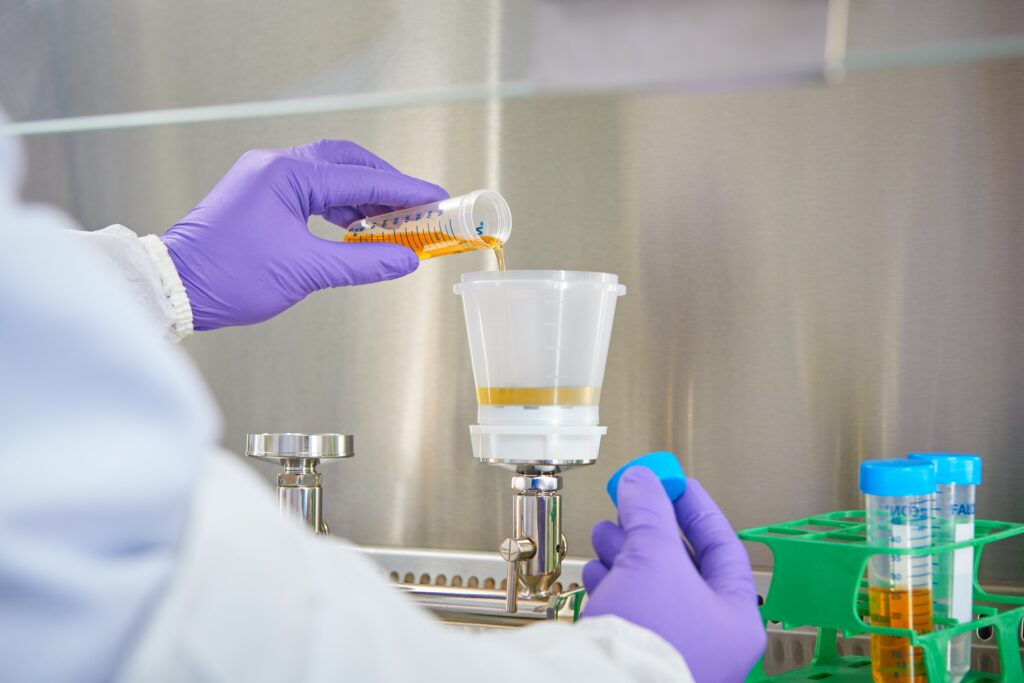
Top 10 Challenges in Bioburden Testing and How to Overcome Them
Bioburden testing is essential in pharmaceutical and medical device manufacturing to ensure product safety and compliance with regulatory standards. However, this process presents several challenges. This blog will explore the top 10 challenges in bioburden testing and provide practical solutions to overcome them.
What is Bioburden Testing?
Definition and Purpose
It measures the number of viable microorganisms on a product before sterilization. It ensures that the sterilization process can effectively reduce microbial load to acceptable levels.
The Process of Bioburden Testing
- Sample Collection: Using sterile tools, collect samples from the product.
- Culturing: Incubate samples in a culture medium to grow any present microorganisms.
- Counting: Count the colony-forming units (CFUs) to determine the bioburden level.
Regulatory Standards and Guidelines
Bioburden testing must comply with standards like ISO 11737, USP <61>, and EP. These guidelines ensure that the testing is accurate and reliable.
Why is Bioburden Testing Critical in Pharmaceutical and Medical Device Manufacturing?
- Ensuring Product Safety and Efficacy: It ensures products are safe by reducing the risk of contamination and infection.
- Compliance with Regulatory Requirements: Regulatory bodies like the FDA and EMA require strict bioburden limits for product approval.
- Preventing Contamination and Ensuring Patient Safety: It prevents contamination, ensuring products are safe and effective for patient use.
What are the Top 10 Challenges in Bioburden Testing?
1. Understanding Bioburden Levels
What are Bioburden Levels?
Bioburden levels refer to the number of microorganisms present on a product before it undergoes sterilization. High bioburden levels increase the risk of contamination.
How to Determine Acceptable Bioburden Levels?
Acceptable bioburden levels vary depending on the product type and intended use. Regulatory guidelines provide thresholds for different categories to ensure safety and compliance.
2. Sample Collection and Handling
Why is Proper Sample Collection Crucial?
Proper sample collection is vital to avoid contamination and ensure accurate results. Incorrect sampling can lead to false positives or negatives, compromising the test’s reliability.
Techniques for Accurate Sample Collection
- Aseptic Technique: Use sterile tools and containers to avoid contamination.
- Sample Size: Ensure the sample size is representative of the entire batch.
3. Method Validation and Verification
What is Method Validation in Bioburden Testing?
Method validation ensures that the testing method accurately measures the bioburden. It involves demonstrating that the method is specific, accurate, precise, and reliable.
How to Validate and Verify Testing Methods?
- Specificity: Ensure the method detects the target microorganisms accurately.
- Accuracy and Precision: Verify that results are consistent and correct through repeated tests.
4. Detecting Low Levels of Microorganisms

Why is Detection Sensitivity Important?
Detection sensitivity is crucial for identifying low levels of microorganisms, which can be critical for ensuring product safety, especially in sterile products.
Methods to Enhance Detection Sensitivity
- Enrichment Culture: Use enrichment techniques to increase the number of detectable microorganisms.
- Advanced Detection Techniques: Employ methods like PCR for more sensitive detection.
5. Interference from Environmental Contaminants
What Environmental Contaminants Affect Bioburden Testing?
Environmental contaminants such as dust, air particles, and personnel can interfere with bioburden testing, leading to inaccurate results.
How to Minimize Environmental Interference?
- Cleanroom Standards: Maintain an ISO Class 5 environment or better.
- Regular Monitoring: Use settle plates and active air sampling to monitor contamination levels.
6. Ensuring Consistency and Repeatability
Why is Consistency Crucial in Bioburden Testing?
Consistency ensures that the results are reliable and reproducible, which is essential for regulatory compliance and product safety.
Techniques to Ensure Repeatable Results
- Standard Operating Procedures (SOPs): Follow detailed, written procedures for all tests.
- Training: Ensure that all personnel are properly trained and regularly updated.
7. Interpreting Test Results
How to Interpret Bioburden Test Results Accurately?
Accurate interpretation of test results is essential to make informed decisions about product safety and compliance.
Common Misinterpretations and How to Avoid Them
- False Positives/Negatives: Confirm results with additional testing.
- Outlier Analysis: Investigate and understand unusual results to avoid misinterpretation.
8. Training and Competency of Personnel
Importance of Proper Training for Bioburden Testing
Proper training ensures that personnel can perform the testing accurately and consistently, which is crucial for reliable results.
How to Train and Assess Competency of Testing Personnel?
- Regular Workshops: Conduct hands-on training sessions.
- Competency Assessments: Perform periodic evaluations to ensure skill levels remain high.
9. Equipment and Technology Limitations
What Equipment is Used in Bioburden Testing?
It involves equipment like incubators, culture media, and microscopes. Each piece of equipment must be properly maintained and calibrated.
How to Overcome Technological Limitations?
- Regular Calibration: Ensure equipment is calibrated for accuracy.
- Maintenance: Follow the manufacturer’s maintenance schedules to prevent breakdowns.
10. Adhering to Regulatory Changes
How Do Regulatory Changes Impact Bioburden Testing?
Regulatory changes can impact testing requirements and procedures, making it essential for manufacturers to stay updated.
Strategies to Stay Updated with Regulatory Requirements
- Regular Review: Stay updated with the latest guidelines and standards.
- Industry Conferences: Attend conferences to learn about the latest regulatory changes and innovations.
How to Overcome Challenges in Bioburden Testing? Few More Tips:

1. Implementing Robust SOPs
What are SOPs and Why are They Important?
Standard Operating Procedures (SOPs) provide a detailed, written guide for performing bioburden tests. They ensure consistency and accuracy across all tests.
How to Develop and Implement Effective SOPs?
- Detail Every Step: Include every action required in testing.
- Regular Updates: Revise SOPs as needed.
- Training: Ensure all staff are trained on the latest SOPs.
2. Utilizing Advanced Technologies
What Advanced Technologies are Available for Bioburden Testing?
- PCR: Polymerase Chain Reaction for detecting low levels of microorganisms.
- Automated Systems: For faster and more accurate results.
Benefits of Using Advanced Technologies
Increased Accuracy: Reduce human error.
Faster Results: Shorten turnaround times.
3. Regular Training and Skill Development
Importance of Continuous Training Programs
Continuous training ensures that staff remain skilled and up to date with the latest methods and technologies.
Methods for Effective Training and Skill Development
- Online Courses: Provide flexible learning options.
- Mentorship Programs: Pair new employees with experienced mentors.
4. Environmental Monitoring and Control
How to Implement an Effective Environmental Monitoring Program?
An effective environmental monitoring program helps control and minimize contamination.
Tools and Techniques for Environmental Control
- HEPA Filters: Use in cleanrooms.
- Air Showers: Install at cleanroom entrances.
5. Regular Audits and Assessments
Why Regular Audits are Necessary
Regular audits ensure compliance with regulatory standards and identify areas for improvement.
How to Conduct Comprehensive Audits and Assessments
- Internal Audits: Conduct frequently.
- Third-Party Audits: Provide an unbiased review.
6. Collaborating with Experts and Consultants
Benefits of Seeking Expert Advice
Experts can provide insights and solutions that may not be apparent internally.
How to Choose the Right Consultants for Bioburden Testing?
- Experience: Look for consultants with a proven track record.
- Reputation: Check references and reviews.
7. Investing in Quality Equipment
Importance of High-Quality Equipment in Bioburden Testing
Quality equipment ensures accurate and reliable test results.
How to Select and Maintain Testing Equipment?
- Research Brands: Choose reliable manufacturers.
- Regular Servicing: Schedule preventative maintenance.
8. Data Management and Analysis
Importance of Data Management in Bioburden Testing
Effective data management ensures the integrity and reliability of test results.
Tools and Techniques for Effective Data Analysis
- LIMS: Use a Laboratory Information Management System.
- Regular Backups: Protect data integrity.
9. Continuous Improvement and Innovation
Why Continuous Improvement is Key?
Continuous improvement ensures that bioburden testing processes remain effective and efficient.
Strategies for Fostering Innovation in Bioburden Testing
- Employee Feedback: Encourage suggestions.
- Pilot Programs: Test new methods before full implementation.
How Prewel Labs Can Help with Bioburden Testing?
Prewel Labs specializes in bioburden testing and provides comprehensive services to ensure your products meet regulatory standards. We have a team of experts and state-of-the-art facilities that guarantee accurate and reliable results.
Clients We Work With
- Pharmaceutical Companies: Ensuring drug safety and compliance.
- Medical Device Manufacturers: Verifying the sterility of devices.
Conclusion
Bioburden testing is crucial for product safety and regulatory compliance. By understanding and overcoming the challenges, you can ensure the reliability of your products. At Prewel Labs, we offer expert solutions to help you manage bioburden levels effectively.
FAQs on Bioburden Testing
1. What types of microorganisms are commonly detected in bioburden testing?
Bioburden testing typically detects a variety of microorganisms, including bacteria, fungi, and spores. Common bacteria include Bacillus, Pseudomonas, and Staphylococcus species, while common fungi include Aspergillus and Candida species.
2. How often should bioburden testing be performed on a product?
The frequency of bioburden testing depends on the product and regulatory requirements. Typically, testing is done at several stages of the production process, including initial development, batch production, and periodic re-evaluation to ensure ongoing compliance.
3. Can bioburden testing be performed on all types of products?
Bioburden testing is suitable for a wide range of products, including pharmaceuticals, medical devices, cosmetics, and food products. However, the specific methods and protocols may vary depending on the product type and regulatory guidelines.
4. What is the difference between bioburden testing and sterility testing?
Bioburden testing measures the number of viable microorganisms on a product before sterilization, whereas sterility testing determines the presence of any microorganisms in a product that is supposed to be sterile. Sterility testing is typically performed on final products after sterilization.
5. What are the common methods used for bioburden testing?
Common methods for bioburden testing include membrane filtration, plate count, and direct inoculation. Each method has its own advantages and is chosen based on the type of product and the regulatory requirements.
6. How do you handle a bioburden test failure?
In the case of a bioburden test failure, it is important to conduct a thorough investigation to determine the cause of the failure. This may include reviewing the production process, environmental controls, and personnel practices. Corrective actions should be implemented to address the root cause.
7. How does bioburden testing impact product shelf life?
Bioburden levels can affect the shelf life of a product, as high levels of microorganisms can lead to spoilage or reduced efficacy over time. Regular bioburden testing helps ensure that products remain safe and effective throughout their shelf life.
8. Are there automated systems available for bioburden testing?
Yes, there are automated systems available that can streamline the bioburden testing process, providing faster and more consistent results. These systems often integrate advanced detection technologies such as PCR or flow cytometry.
9. How do environmental conditions affect bioburden testing results?
Environmental conditions, such as temperature, humidity, and air quality, can significantly impact bioburden testing results. Proper environmental monitoring and control are essential to ensure accurate and reliable results.
10. What is the role of bioburden testing in the validation of cleaning processes?
Bioburden testing plays a crucial role in validating cleaning processes by ensuring that cleaning methods effectively reduce microbial contamination to acceptable levels. Regular bioburden testing helps verify that cleaning processes remain effective over time.

